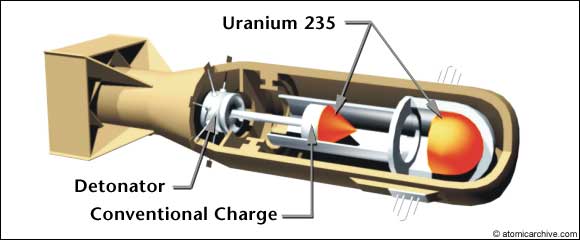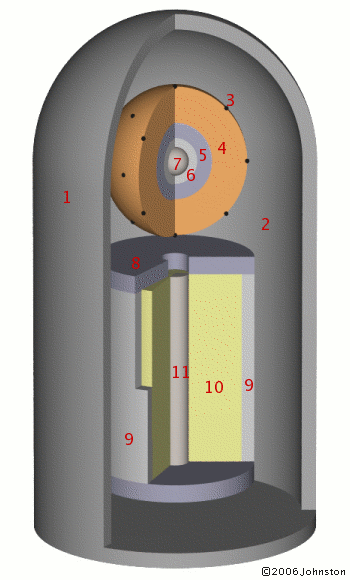| Time Travel Research Center © 2005 Cetin BAL - GSM:+90 05366063183 - Turkey/Denizli |
Fat Man: Implosion-Type Bomb

The rapid spontaneous fission rate of plutonium 239 necessitated that a different type of bomb be designed. A gun-type bomb would not be fast enough to work. Before the bomb could be assembled, a few stray neutrons would have been emitted, and these would start a premature chain reaction, leading to a great reduction in the energy released.
Seth Neddermeyer, a scientist at Los Alamos, developed the idea of using explosive charges to compress a sphere of plutonium very rapidly to a density sufficient to make it go critical and produce a nuclear explosion.
Little Boy: A Gun-Type Bomb

In essence, the Little Boy design consisted of a gun that fired one mass of uranium 235 at another mass of uranium 235, thus creating a supercritical mass. A crucial requirement was that the pieces be brought together in a time shorter than the time between spontaneous fissions. Once the two pieces of uranium are brought together, the initiator introduces a burst of neutrons and the chain reaction begins, continuing until the energy released becomes so great that the bomb simply blows itself apart.
The Hydrogen Bomb: Schematic

The yield of a hydrogen bomb is controlled by the amounts of lithium deuteride and of additional fissionable materials. Uranium 238 is usually the material used in various parts of the bomb's design to supply additional neutrons for the fusion process. This additional fissionable material also produces a very high level of radioactive fallout.
The Hydrogen Bomb: The Basics
A fission bomb, called the primary, produces a flood of radiation including a large number of neutrons. This radiation impinges on the thermonuclear portion of the bomb, known as the secondary. The secondary consists largely of lithium deuteride. The neutrons react with the lithium in this chemical compound, producing tritium and helium.
This reaction produces the tritium on the spot, so there is no need to include tritium in the bomb itself. In the extreme heat which exists in the bomb, the tritium fuses with the deuterium in the lithium deuteride.
The Neutron Bomb
The neutron bomb is a small hydrogen bomb. The neutron bomb differs from standard nuclear weapons insofar as its primary lethal effects come from the radiation damage caused by the neutrons it emits. It is also known as an enhanced-radiation weapon (ERW).
The augmented radiation effects mean that blast and heat effects are reduced so that physical structures including houses and industrial installations, are less affected. Because neutron radiation effects drop off very rapidly with distance, there is a sharper distinction between areas of high lethality and areas with minimal radiation doses.
This was desired by the forces of the North Atlantic Treaty Organization (NATO), since they have to be prepared to fight in densely populated areas; any tactical nuclear explosion will endanger civilian lives and property.
Time of Reaction
The released neutron travels at speeds of about 10 million meters per second, or about 3% the speed of light. The characteristic time for a generation is roughly the time required to cross the diameter of the sphere of fissionable material.
A critical mass of uranium is about the size of a baseball (0.1 meters). The time, T, the neutron would take to cross the sphere is:
| T = | 0.1 meters 1 x 10 7 meters/second |
| = | 1 x 10 -8 seconds |
The complete process of a bomb explosion is about 80 times this number, or about a microsecond.
This time was informally known as a 'shake' ("as fast as the shake of a lamb's tail") by the physicists at Los Alamos.
Why Uranium and Plutonium?
Scientists knew that the most common isotope, uranium 238, was not suitable for a nuclear weapon. There is a fairly high probability that an incident neutron would be captured to form uranium 239 instead of causing a fission. However, uranium 235 has a high fission probability.
Of natural uranium, only 0.7% is uranium 235. This meant that a large amount of uranium was needed to obtain the necessary quantities of uranium 235. Also, uranium 235 cannot be separated chemically from uranium 238, since the isotopes are chemically similar.
Alternative methods had to be developed to separate the isotopes. This was another problem for the Manhattan Project scientists to solve before a bomb could be built.
Research had also predicted that plutonium 239 would have a high fission probability. However, plutonium 239 is not a naturally occurring element and would have to be made. The reactors at Hanford, Washington were built to produce plutonium.
Implosion-Type Bomb: Detonation Sequence
- The high explosive surrounding the fissile material is ignited.
- A compressional shock wave begins to move inward. The shock wave moves faster than the speed of sound and creates a large increase in pressure. The shock wave impinges on all points on the surface of the sphere of the fissile material in the bomb core at the same instant. This starts the compression process.
- As the core density increases, the mass becomes critical, and then supercritical (where the chain reactions grows exponentially).
- Now the initiator is released, producing many neutrons, so that many early generations are bypassed.
- The chain reaction continues until the energy generated inside the bomb becomes so great that the internal pressure due to the energy of the fission fragments exceed the implosion pressure due to the shock wave.
- As the bomb disassembles, the energy released in the fission process is transferred to the surroundings.
Simplified schematic of a multistage thermonuclear weapon

|
Numbered parts:
|
Sequence of events in explosion:
STAGE 1: fission explosion
- Multiple detonators (3) simultaneously initiate detonation of high explosives (4).
- As detonation progresses through high explosives (4), shaping of these charges transforms the explosive shock front to one that is spherically symmetric, travelling inward.
- Explosive shock front compresses and transits the pusher (5) which facilitates transition of the shock wave from low-density high explosive to high-density core material.
- Shock front in turn compresses the reflector (5), tamper (6), and fissile core (7) inward.
- When compression of the fissile core (7) reaches optimum density, a neutron initiator (either in the center of the fissile core or outside the high explosive assembly) releases a burst of neutrons into the core.
- The neutron burst initiates a fission chain reaction in the fissile core (7): a neutron splits a plutonium/uranium-235 atom, releasing perhaps two or three neutrons to do the same to other atoms, and so on; energy release increases geometrically.
- Many neutrons escaping from the fissile core (7) are reflected back to it by the tamper (6) and reflector (5), improving the chain reaction.
- The mass of the tamper (6) delays the fissile core (7) from expanding under the heat of the building energy release.
- Neutrons from the chain reaction in the fissile core (7) cause transmutation of atoms in the uranium-235 tamper (6).
- As the superheated core expands under the energy release, the chain reaction ends.
STAGE 2: fusion explosion
- Gamma radiation from the fission explosion superheats the filler material (2), turning it into a plasma.
- The vaporized filler material (2) is delayed from expanding outward by the bomb casing (1), increasing its tendency to compress the fusion pusher/tamper (9).
- Compression reaches the fusion fuel (10), which has been partially protected from gamma radiation by the radiation shield (8).
- Compression reaches the fissile sparkplug (11), compressing it to a super-critical mass.
- Neutrons from the explosion of stage 1 reach the fissile sparkplug (11) through the channel in the radiation shield (8), initiating a fission chain reaction.
- The sparkplug (11) explodes outward.
- The fusion fuel (10) is now supercompressed between the fusion pusher/tamper (9) from without and the sparkplug (11) from within, turning it into a superheated plasma.
- Lithium and deuterium nuclei collide in the fusion fuel (10) to produce tritium, and tritium and deuterium nuclei engage in fusion reactions: nuclei fuse by pairs into helium nuclei, producing a large energy release of gamma rays, neutrons, and heat.
- The large release of neutrons from fusion in the fusion fuel (10) causes transmutation of uranium-235 atoms in the fusion pusher/tamper (9), releasing additional energy.
- All reactions end as the superheated remnants expand under the energy release; the entire weapon is vaporized.
- Total elapsed time: about 0.00002 seconds.
Alıntı: © 2001-2003, 2006 by Wm. Robert Johnston. - Last modified 10 September 2006.
Hiçbir yazı/ resim izinsiz olarak kullanılamaz!! Telif hakları uyarınca bu bir suçtur..! Tüm hakları Çetin BAL' a aittir. Kaynak gösterilmek şartıyla siteden alıntı yapılabilir.
The Time Machine Project © 2005 Cetin BAL - GSM:+90 05366063183 -Turkiye/Denizli
Ana Sayfa /index /Roket bilimi /![]() E-Mail /CetinBAL/Quantum Teleportation-2
E-Mail /CetinBAL/Quantum Teleportation-2
Time Travel Technology /Ziyaretçi Defteri /UFO Technology/Duyuru